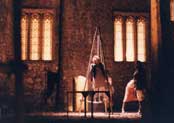OPERA SEARCH

The Martyrdom of St Magnus
(1976)Libretto by the composer after the novel by George Mackay Brown (E,G)
M,T,2Bar,B
fl(=picc,afl).cl(=bcl)-hn.2tpt-perc(1):marimba/glsp/crot/2SD/
rototoms/2BD/pedal timp/2Chin.cym/2susp.cym(bowed)/
Burmese nipple gongs/2Japanese gongs/tam-t(with soapdish)/blackboard/
sandpaper/3 pairs claves (played by singers off-stage)-keyboards(1):
hpd,keyboard carillon (or cel),cel,autoharp (or zither),upright pft,(
=flex,railway whistle)-guitar(=tabor)-vla.vlc.db
Abbreviations (PDF)
Boosey & Hawkes
St Magnus Cathedral, Kirkwall, Orkney
Murray Melvin, director
Conductor: Peter Maxwell Davies
Company: The Fires of London
| EARL MAGNUS/PRISONER/REPORTER I/MONK | Tenor |
| NORSE HERALD/KING OF NORWAY/KEEPER OF THE LOOM/POLICEMAN/HERALD OF EARL MAGNUS/REPORTER II/LITOLF THE BUTCHER/MONK | Baritone |
| WELSH HERALD/TEMPTER/HERALD OF EARL HAKON/REPORTER III/MONK/POLICEMAN | Baritone |
| EARL HAKON/MILITARY OFFICER/REPORTER IV/BISHOP OF ORKNEY/MONK | Bass |
| BLIND MARY/MARY O'CONNELL/THE GIRL INGERTH | Mezzo-Soprano |
Orkney, 12th Century
by Paul Griffiths
Blind Mary, accompanied by a guitar, introduces the first of the nine scenes, in which Magnus is involved in a battle between the Norsemen and the Welsh. He prefers to fight with the words of Psalm 23 rather than arms, and his side is victorious. In Scene 2 he withstands the temptations of fame, marriage, kingship, religious retreat and armed force; the much shorter Scene 3 has Blind Mary, again with guitar, lamenting the state of an Orkney torn by civil war between Magnus and Håkon. Bishop and heralds then agree on a peace conference to take place on the island of Egilsay, whether Magnus is seen voyaging in Scene 5; the great part of the scene is an aria in which he resolves to go ahead no matter what he fears might happen. The musical style then becomes much wilder as Håkon orders Magnus' execution, and in Scene 7 both action and music come forward to the present as journalists report on the political situation. Scene 8 is fully in the present, or the recent past: Håkon is a hysterical officer and Magnus merely a Prisoner, who quietly meets his fate. The last scene is Blind Mary's: she prays to Magnus for the return of her sight, and gains it, while the rest of the cast as monks add Magnus' name to the litany of northern saints.
by Paul Griffiths
Magnus was a twelfth-century earl of the Orkney Islands, a Viking unusual for his pacifism, martyred in a dynastic struggle. The opera is a presentation of his story, based on George Mackay Brown's novel Magnus and devised to be played continuously, with a quite simple, stylized staging. In form the opera is somewhat liturgical, though often fiercely dramatic in its action and in its vocal comportment. The instrumental writing, too, is thoroughly virtuoso, being intended for The Fires of London with guitar and brass.
Dramatic
